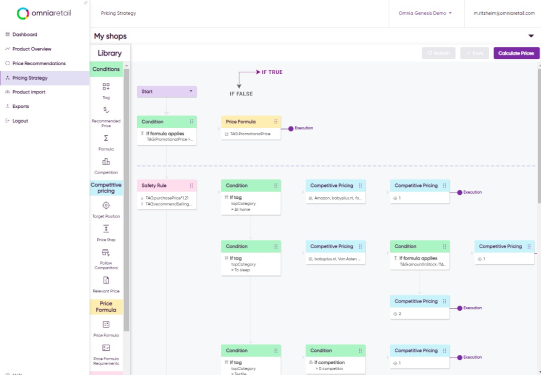From humble beginnings as an online bookstore in 1994 to becoming the fourth most valuable public company with a market capitalization of $2.36 trillion in 2025, Amazon’s journey offers valuable lessons for retailers and brands alike.
Amazon's strategies for success have evolved significantly since the company’s founding, but some core principles have remained the same. To understand these strategies, it’s essential to look at their customer-centric philosophy, technological innovation, and use of dynamic pricing on Amazon that continue to reshape multiple industries.
What strategies has Amazon implemented to maintain its competitive edge in e-commerce? How have they managed to expand from books to cloud computing, entertainment, healthcare, and beyond? This comprehensive guide explores the key strategies behind Amazon’s remarkable success and what businesses can learn from its approach in 2025.
“Do whatever it takes to make the customer happy.”
- Amazon
What is Amazon’s Goal? Understanding the Company’s Mission
Amazon's mission is straightforward: "Earth's most customer-centric company." This statement has guided the company’s strategy for nearly three decades. Jeff Bezos's 1997 letter to shareholders (which Amazon still attaches to annual reports) outlined a focus on long-term market leadership over short-term profitability. This philosophy has allowed Amazon to make bold investments that might seem questionable in the short term but create substantial long-term value.
Beyond retail, Amazon identifies customer pain points across industries, offering convenience, selection, and value, for example, AWS, its own tech ecosystem (like Alexa or Kindle), and entertainment (like Prime Video). This approach has disrupted markets from cloud computing to healthcare. Unlike traditional retailers focused on quarterly profits, Amazon prioritizes market position and customer loyalty for sustainable growth.
Core Business Strategies
The most effective Amazon strategies for success revolve around long-term thinking and their obsession with customer satisfaction. This patient capital approach has allowed the company to invest in infrastructure, technology, and new business lines that take years to become profitable.
Amazon’s core business strategies include:
- Customer obsession: Making decisions based on customer needs rather than competitor actions or short-term financial considerations.
- Long-term thinking: Willingness to be misunderstood for long periods while pursuing innovative ideas that may take years to prove successful.
- Continuous innovation: Treating “Day 1” as a permanent state of mind to maintain startup agility despite massive scale.
- Operational excellence: Relentless focus on efficiency, speed, and quality in all aspects of the business.
By maintaining these consistent values while adapting tactics to different markets, Amazon has created a cohesive yet flexible strategic framework.
Amazon Business Level Strategy: From Retail to Tech Giant
Amazon's business-level strategy combines cost leadership with differentiation in a hybrid approach that few competitors can match. While traditional strategy theory suggests companies should choose either cost leadership or differentiation, Amazon has successfully pursued both simultaneously.
The company has evolved from selling books to creating a comprehensive ecosystem of products and services that reinforce each other. This ecosystem approach creates powerful network effects and switching costs that help retain customers and drive growth across business units.
Amazon’s strategy focuses on entering and disrupting traditional industries through technology and customer experience improvements. For example, their acquisition of Whole Foods wasn’t simply about entering grocery retail but reimagining the grocery shopping experience through technology integration.
Amazon’s business level strategies can be categorized into three main approaches:
- Corporate level strategy: Diversification into related and unrelated businesses that can benefit from Amazon’s core competencies in technology, logistics, and customer data.
- Business level strategy: Hybrid approach combining cost leadership and differentiation within each business unit.
- Functional level strategy: Operational excellence through automation, data analytics, and continuous process improvement.
This multi-layered strategic approach allows Amazon to maintain coherence across diverse business units while adapting to the specific requirements of each market it enters.
Amazon Sales Strategy: How the E-commerce Leader Drives Revenue
Amazon's sales strategy heavily relies on personalization and recommendation algorithms, generating an estimated 35% of retail revenue through cross-selling and upselling.
Their core approach maximizes selection and minimizes prices, making it harder for competitors to compete with them. This has led to them capturing 38-40% of the U.S. e-commerce market by 2025. While initially focusing on first-party sales, Amazon now emphasizes its marketplace, with third-party sellers accounting for 60% of unit sales.
Amazon Dynamic Pricing Model: Algorithmic Advantage
The dynamic pricing model represents one of their most sophisticated competitive advantages. Amazon’s pricing algorithms analyze over 400 million price changes daily, adjusting based on:
- Competitor pricing
- Customer browsing and purchase history
- Inventory levels
- Time of day and seasonal factors
- Demand forecasting data
Win the Buy Box—Without Racing to the Bottom

This algorithmic approach allows the company to optimize margins while maintaining its reputation for competitive pricing. For high-visibility products that shape price perception (known as “key value items”), Amazon maintains aggressive pricing, while potentially earning higher margins on less price-sensitive items.
For retailers and brands competing with Amazon, understanding this dynamic pricing approach is strategically important. Static pricing strategies simply cannot compete with Amazon’s algorithmic advantage, making dynamic pricing technology an essential investment for competitive e-commerce operations.
The Importance of Dynamic Pricing for Retailers and DTC Brands
For retailers and direct-to-consumer (DTC) brands, dynamic pricing has become a critical factor in staying competitive. As consumer expectations for real-time price fairness and responsiveness increase, businesses must leverage pricing automation to react instantly to market shifts, competitor actions, and changing demand. Dynamic pricing enables brands to protect margins, avoid price erosion, and strengthen their positioning on marketplaces such as Amazon, where algorithmic speed and precision often determine who wins the sale.
Marketplace Strategy
Amazon’s marketplace strategy has evolved from a supplementary sales channel to the core of its retail business model. By opening their platform to third-party sellers, Amazon has:
- Dramatically expanded product selection without inventory investment
- Created a new revenue stream through commissions and seller services
- Gathered valuable data on product trends and pricing
- Established a virtuous cycle where more sellers attract more buyers, and vice versa
This platform approach has taken Amazon from being a retailer to a complex retail ecosystem, with significant implications for brands and retailers. For many brands, the question is no longer whether to sell on Amazon but how to optimize their Amazon strategy while maintaining other sales channels.
TikTok Shop and Viral Trends: Using Social Media to Drive Sales
Amazon has changed its social media approach from basic product promotion to a sophisticated strategy that’s deeply rooted in data analysis. With over 43 million followers across major platforms, Amazon implements a three-pronged strategy to capitalize on social trends:
- Real-time trend monitoring: Using AI-powered listening tools, Amazon identifies emerging product trends by analyzing hashtag velocity and engagement patterns. When potential viral products are detected, category managers are automatically alerted to adjust inventory and marketing strategies.
- Platform-specific optimization: Rather than using uniform content, Amazon tailors their approach to each platform’s unique characteristics, embracing short-form video on TikTok, creating shoppable Reels on Instagram, and developing longer educational content on YouTube.
- Seamless purchase integration: Amazon has minimized friction between product discovery and purchase through innovations like “shoppable collages” and direct integrations with platforms like TikTok Shop, allowing consumers to complete transactions without leaving their social media experience.
-png.png?width=653&height=367&name=Blog%20covers%20(4)-png.png)
Amazon's social commerce drives 10.33% conversion rates, nearly eight times the industry average. Viral content boosts product sales by 412% within 48 hours. This success stems from integrating social listening with inventory and pricing, allowing Amazon to quickly capitalize on trends and avoid stock shortages.
Amazon Prime Day 2025: Data Analysis and Strategic Insights
Prime Day in 2025 was another “record-breaking sales event” for the company as Amazon extended it to a 4-day event instead of the usual two days. As Prime Day is slowly becoming almost like its own holiday, Amazon is strategically using this period to increase its market share, drive revenue, strengthen customer loyalty, and promote its own tech ecosystem.
Here are some of Amazon’s key strategies for Prime Day:
- Market share and traffic expansion: Extending Prime Day smooths demand while capturing incremental traffic. This year, average daily orders were 136% higher than year-to-date averages, demonstrating sustained impact even across longer timeframes. In Europe, especially, "hero" products like Ring and Sony headphones serve as traffic magnets. However, Amazon notably withheld a crucial metric for 2025: total items sold, which they previously reported as 375 million in 2023 and 300 million in 2022. While the extension resulted in greater total sales volume, it paradoxically led to lower daily average sales compared to the previous year.
- Ecosystem lock-in through device promotion: Amazon heavily discounts its own hardware (Echo, Fire TV, Kindle, Ring) to drive long-term ecosystem engagement. Amazon tech products, including Fire TV, Echo, Kindle, and Ring, averaged 30% off, while Amazon aggressively discounted its Private Brands and Everyday Essentials by up to 40%.
- Strategic pricing tactics before and during Prime Day: Omnia's analysis found a clear pricing pattern based on the average pricing trends leading up to Prime Day: prices climbed from €142.78 a month before to €148.28 weeks before Prime Day, then "discounted" back to €142.77, essentially month-old levels. Most telling, 54.9% of products showed no price drop, with 45.5% actually increasing.
.png?width=789&height=443&name=LinkedIn%20Visuals%20-%20Sander%20(5).png)
- Competitive market response: European competitors responded aggressively: bol.com offered deeper cuts on 14% of identical products, while MediaMarkt exceeded Amazon's discounts on 16% of analyzed products.
- AI-driven engagement control: Prime Day's massive traffic provides optimal conditions for testing and promoting Rufus, Amazon's AI shopping assistant, strategically nudging visitors to interact and train the AI model.
Amazon Technological Innovations Driving Competitive Advantage
The company’s technological innovations, like AWS, AI shopping assistant Rufus, Alexa, and warehouse robotics, have changed multiple industries and created substantial competitive advantages. Their willingness to invest heavily in R&D (over $73 billion in 2024) has enabled them to maintain technological leadership across multiple domains.
Recent Amazon technological innovations include AI-powered demand forecasting and generative mapping technology (Wellspring.) Their demand forecasting system has achieved a 10% improvement in national forecasts and 20% in regional forecasts, directly enhancing inventory placement and reducing delivery times.
Amazon AI and Machine Learning: Powering Next-Gen Retail
Amazon’s AI and machine learning capabilities have become central to its competitive advantage across all business units. Recent developments include:
- AWS Generative AI Innovation Center: An additional $100 million investment announced in July 2025, focusing on autonomous, agentic AI systems that are projected to influence 15% of work decisions by 2028.

Source: Reuters
- Wellspring Mapping Technology: A generative AI solution that has enhanced delivery accuracy for over 2.8 million apartment addresses, solving a persistent last-mile delivery challenge.
- AI-Powered Demand Forecasting: Sophisticated prediction models that have significantly improved inventory placement and reduced delivery times.
According to Amazon CTO Dr. Werner Vogels, key strategic priorities for their AI development include mission-driven workforce development, energy efficiency innovations, and tools for combating disinformation.
Amazon Robotics Strategy: Automating for Efficiency
The Amazon robotics strategy focuses on automating repetitive tasks while enhancing human capabilities rather than replacing workers entirely. Their warehouse robotics program now includes over 750,000 robots working alongside human employees.
Recent advances in their robotics program include:
- Agentic Robotics: Systems that can understand natural language commands and adapt to changing warehouse conditions.
- Collaborative Robots: Machines designed to work safely alongside human workers, enhancing productivity while reducing physical strain.
- Autonomous Mobile Robots (AMRs): Self-navigating vehicles that transport items throughout fulfillment centers, reducing walking time for human workers.
These robotics investments have improved warehouse efficiency by approximately 20% while also reducing workplace injuries by 32% since 2019, demonstrating how technology can enhance both productivity and safety.
Amazon Fulfillment Network Strategy: Revolutionizing Logistics
Amazon's fulfillment strategy leverages a vast network of over 185 U.S. fulfillment centers (as of 2025) for rapid, cost-effective delivery by positioning inventory close to customers. Continuous investment in automation and robotics, including their $1 billion Industrial Innovation Fund, drives logistics innovation and improves safety.
Sellers can choose from two main Amazon fulfillment options:
|
Fulfillment Method |
Description |
Advantages |
Disadvantages |
|
Fulfillment by Amazon (FBA) |
Amazon stores, picks, packs, and ships products |
Prime eligibility, higher conversion rates, simplified operations |
Higher fees, less control over inventory |
|
Fulfillment by Merchant (FBM) |
Seller handles storage and shipping |
Lower fees, more control, better for certain product types |
No Prime badge (unless SFP-eligible), lower conversion rates |
The choice between these options depends on product characteristics, margins, and operational capabilities. Many successful sellers use a hybrid approach, using FBA for fast-moving items and FBM for larger, lower-margin products.
Recent innovations in Amazon’s fulfillment network include:
- Operations Innovation Lab in Milan: A testing ground for new logistics technologies before wider deployment.
- Last-Mile delivery solutions: Including Amazon Locker, Key by Amazon, and drone delivery trials.
- Sustainable logistics initiatives: Electric delivery vehicles and packaging reduction programs that align with environmental goals while reducing costs.
Amazon Seller Performance Metrics: Key Success Factors
Amazon seller performance metrics include order defect rate, late shipment rate, and cancellation rate. These metrics directly impact seller visibility, Buy Box eligibility, and account health, making them crucial for marketplace success.
Key metrics Amazon uses to evaluate sellers include:
|
Metric |
Target |
Impact if Below Target |
|
Order Defect Rate |
<1% |
Loss of Buy Box eligibility, potential account suspension |
|
Late Shipment Rate |
<4% |
Reduced visibility, loss of Buy Box eligibility |
|
Cancellation Rate |
<2.5% |
Reduced visibility, potential inventory restrictions |
|
Valid Tracking Rate |
>95% |
Reduced visibility, potential delivery performance warnings |
|
Customer Response Time |
<24 hours |
Lower seller rating, potential impact on Buy Box eligibility |
Amazon's strict performance standards, driven by customer experience, demand robust inventory, efficient fulfillment, and responsive customer service from sellers. This meritocratic system, prioritizing operational capabilities over traditional retail relationships, gives superior sellers an advantage.
Amazon Advertising Platform: A Growing Revenue Stream
Amazon's ad platform is now the third-largest in the US, generating over $46 billion in 2024 and significantly boosting Amazon's profitability. Recent updates like AI Audience Builder and Multi-Country Campaign View enhance its capabilities.
For brands and sellers, Amazon’s advertising platform offers unique advantages compared to other digital advertising channels:
- High Purchase Intent: Amazon users typically have stronger purchase intent than users on social media or content sites.
- Closed-Loop Attribution: Direct connection between ad exposure and purchase behavior within the same platform.
- Rich Customer Data: Amazon’s extensive purchase history data enables sophisticated targeting.
- Product-Based Targeting: Ability to target competitors’ products or complementary items.
Amazon's advertising platform is crucial for brands and retailers. Due to increased competition for organic visibility, paid advertising is now vital for success on Amazon, demanding specialized expertise and budget.
What Factors Contributed to Amazon’s Success Over Time?
What factors contributed to Amazon’s success over the decades? Several key elements stand out:
- First-Mover Advantage: Amazon recognized the potential of e-commerce earlier than most traditional retailers, allowing them to build infrastructure and customer relationships before competition intensified.
- Leadership Vision: Jeff Bezos’s clear strategic vision and willingness to make unconventional decisions provided consistent direction despite rapid growth and market changes.
- Patient Capital Approach: By prioritizing long-term market position over short-term profits, Amazon made investments that would have been impossible under traditional retail financial expectations.
- Strategic Acquisitions: Key acquisitions like Zappos, Whole Foods, and MGM strengthened Amazon’s position in strategic markets and brought valuable capabilities into the organization.
- Technological Innovation: Continuous investment in technology created competitive advantages across all business units, from retail recommendation engines to AWS cloud infrastructure.
- Flywheel Effect: Amazon created virtuous cycles where each part of the business reinforces the others, creating accelerating momentum as the company grows.
These factors combined to create a uniquely powerful business model that continues to disrupt traditional industries and expand into new markets.
Amazon Market Dominance: By the Numbers
Amazon’s market dominance is reflected in impressive financial and operational metrics that demonstrate its continued growth trajectory:
|
Metric |
Value |
Year-over-Year Change |
|
Market Capitalization |
$2.36 trillion |
4th most valuable public company |
|
Net Sales (2024) |
$638 billion |
11% increase |
|
Net Income (2024) |
$59.2 billion |
95% increase |
|
Q2 2025 Net Sales |
$167.7 billion |
13% increase |
|
AWS Revenue (Q2 2025) |
$30.9 billion |
17.5% increase |
|
Active Users Globally |
309 million |
7% increase |
|
Registered Sellers |
9.7 million |
12% increase |
|
U.S. E-commerce Market Share |
38-40% |
2 percentage point increase |
|
Third-Party Seller Unit Share |
60% |
3 percentage point increase |
These numbers illustrate Amazon’s continued growth despite its massive scale, with particularly strong performance in high-margin businesses like AWS and advertising, with projected 2025 revenue of $700 billion. Competitors find direct competition difficult, opting instead to focus on specialized niches, unique customer experiences, or complementary services to gain an advantage.
Amazon Future Outlook 2025: Strategic Direction and Predictions
Looking ahead to the remainder of 2025 and beyond, several key trends are shaping Amazon’s strategic direction:
- AI Integration Across All Business Units: Amazon is accelerating AI deployment throughout its operations, from customer-facing applications like product recommendations to back-end systems for demand forecasting and logistics optimization.
- Healthcare Expansion: Following their acquisition of One Medical and launch of Amazon Pharmacy, healthcare represents a major growth opportunity with significant disruption potential.
- Sustainability Initiatives: Amazon’s Climate Pledge commitments are driving investments in renewable energy, electric delivery vehicles, and sustainable packaging that align with environmental goals, with operational efficiency.
- International Growth Focus: While North America remains Amazon’s largest market, they’re increasingly focusing on high-growth international markets, particularly India and Latin America.
- Regulatory Challenges: Growing regulatory scrutiny in the U.S. and EU may constrain certain expansion strategies and business practices, potentially creating opportunities for competitors.
These strategic directions suggest Amazon will continue its pattern of disrupting traditional industries through technology and customer experience innovations while facing increasing competitive and regulatory challenges.
Read about more interesting blog posts here:
- What is Dynamic Pricing?: The ultimate guide to dynamic pricing.
- What our the best pricing strategies?: Read about 17 pricing strategies for you as a retailer or brand.
- What is Price Monitoring?: Check out everything you need to know about price comparison and price monitoring.
- What is Value Based Pricing?: A full overview of how price and consumer perception work together.
- What is Charm Pricing?: A short introduction to a fun pricing method.
- What is Penetration Pricing?: A guide on how to get noticed when first entering a new market.
- What is Bundle Pricing?: Learn more about the benefits of a bundle pricing strategy.
- What is Cost Plus Pricing?: In this article, we’ll cover cost-plus pricing and show you when it makes sense to use this strategy.
- What is Price Skimming?: Learn how price skimming can help you facilitate a higher return on early investments.
- What is Map Pricing?: Find out why MAP pricing is so important to many retailers.
Frequently asked questions
Your frequently asked questions about Amazon's pricing strategy, the company's success, and insights into business strategies for retailers and brands.
What makes Amazon different from its competitors?
Amazon’s fundamental difference lies in its decision-making framework. While most companies make decisions based on competitor actions or financial metrics, Amazon starts with the customer and works backward. This customer-centric approach led them to create services like one-click ordering, personalized recommendations, and hassle-free returns before competitors recognized these as competitive advantages. Their willingness to cannibalize their own products to better serve customers, like developing Kindle to disrupt their profitable book business, demonstrates this commitment in action.
What is Amazon’s core business strategy?
Amazon’s core strategy revolves around building what they call “customer love” through three pillars: vast selection, low prices, and fast delivery. However, the deeper strategy involves using these customer-facing benefits to generate data and scale that creates barriers for competitors. Every customer interaction provides information that improves their recommendation algorithms, inventory management, and pricing strategies. This data advantage becomes more powerful as their customer base grows, creating a self-reinforcing cycle of improvement.
How has Amazon’s strategy evolved over time?
Amazon’s strategy has evolved from “Earth’s biggest bookstore” to “Earth’s most customer-centric company,” but the underlying principles remain consistent. They’ve expanded from books to everything, from retail to cloud services, from physical products to digital content. Each expansion follows the same pattern: identify customer pain points, develop solutions that seem unprofitable initially, then scale those solutions until they become competitive advantages. This evolution shows strategic consistency despite tactical flexibility.
What role does technology play in Amazon’s success?
Technology serves as Amazon’s primary competitive weapon, but not in the way most people think. Rather than using technology to reduce costs, Amazon uses it to improve customer experiences and gather intelligence about market trends. Their recommendation engine, dynamic pricing algorithms, and predictive analytics don’t just optimize operations, they create personalized experiences that increase customer loyalty and lifetime value. This technology-driven personalization at scale is something traditional retailers struggle to replicate.
Why do customers remain loyal to Amazon?
Customer loyalty to Amazon stems from what behavioral economists call “habit formation” combined with genuine value delivery. Amazon makes shopping so convenient and reliable that customers develop automatic purchasing behaviors. Their investment in customer service, easy returns, and consistent delivery creates trust that reduces the perceived risk of online shopping. Prime membership adds a psychological commitment device; customers want to maximize the value of their membership fee, which encourages more frequent purchases.
What can other businesses learn from Amazon’s approach?
The key lesson from Amazon’s success is the power of long-term thinking combined with customer obsession. Most businesses can’t replicate Amazon’s scale, but they can adopt its decision-making framework: start with customer needs, work backward to solutions, and be willing to sacrifice short-term profits for long-term market position. Amazon’s success also demonstrates the importance of treating data as a strategic asset and using technology to enhance rather than replace human decision-making.



.png?height=766&name=Untitled%20design%20(21).png)
